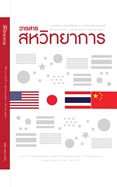Japanism in Traditional Thai Art: The Reflection of Global Learning in Thai Society during the Ayuthaya and Early Bangkok Period.
Keywords:
Mural Painting, Wat Yom, Japanese Images, Ratanakosin PeriodAbstract
This article has an aim to study traces of the relations with Japan which appeared in traditional Thai art, traditional pictorial books, mural paintings, and part of architecture. These traces might be used to explain the Thai-Japanese relations through art in the past and could be reflected in the Thai society’s learning perceptions of the outside world in the time that the art was created. The research methodology in art history was utilized here by means of surveying sites and sources of art, Buddhai Sawan Throne Hall in Bangkok National Museum, the pictorial book of the royal procession in the reign of King Narai (the picture book of mural paintings at Wat Yom in Ayutthaya), and mural paintings at Wat Phra Chetuphon Wimonmangkhalaram (Wat Po) and Wat Bangkhuntien Nok. Its age was then determined and compared with documents, and analyzed.
The survey shows that from sites and sources of art, there were relations with Japan in various aspects. At Buddhai Sawan Throne Hall, its eaves (edges of a roof) could be compared with eaves of the Japanese-style buildings. It might be the creativity of the Front Palace’s craftsmen who were praised for their skills and avant-garde thinking at that time. The Japanese men who were assumed the Japanese militia appeared on the mural painting at Wat Yom as part of the royal land procession in the reign of King Narai in the Ayutthaya period. Nowadays, it faded away but was copied into the pictorial book. People from 12 foreign lands (12 languages) were painted at small pavilions around the temple ground at Wat Phra Chetuphon, together with poems and pictures describing a character of the Japanese man. Pictures of the Japanese men were also appeared at window panels at Wat Bangkhuntien Nok in Jomthong area, Bangkok. These pictures might be related to pictures of people from 12 foreign lands (12 languages) at Wat Phra Chetuphon. The art’s age from both sites was determined by art historians that it should be created in the early Bangkok period.
From this evidence, it could be analyzed for 2 points. Firstly, there were relations between the kingdom of Siam and Japan since the past in various aspects, trade relations, political roles of the Japanese people in the kingdom of Siam which became historical evidence in the form of art, and art inspiration for each other. Secondly, the mural paintings of the Japanese people also reflected conditions of the Thai society at that time of the art’s creation. It was an adaptation to learn and perceive the outside world, to have acquaintance with people from other lands for their costume and noticeable personality characters and create the art in order that people could learn and understand it because in the early Ratanakosin period, the Thai society was about to contact with the outside world and form relations with foreigners in different dimensions. This was consistent in the Thai society’s currents of learning and perceiving the outside world. Therefore, knowledge of different things was essential and promulgated to ordinary people by means of the art.
Downloads
Published
How to Cite
Issue
Section
License
บทความทัศนะ ข้อคิดเห็น ภาพที่ปรากฏ ในวารสารเล่มนี้เป็นความคิดเห็นส่วนตัวของผู้เขียน บรรณาธิการและกองบรรณาธิการไม่จำเป็นต้องเห็นพ้องด้วย และไม่ถือเป็นความรับผิดชอบ ลิขสิทธิ์เป็นของผู้เขียนและวิทยาลัยสหวิทยาการ มหาวิทยาลัยธรรมศาสตร์ การตีพิมพ์ชื่อต้องได้รับอนุญาตจากผู้เขียน และวิทยาลัยสหวิทยาการโดยตรง และเป็นลายลักษณ์อักษร







